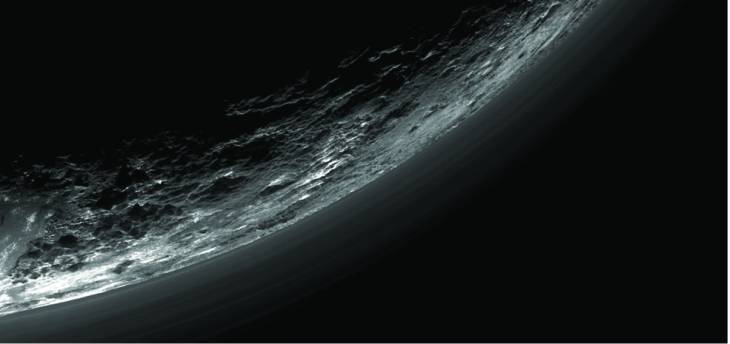The New Horizons science team has published new findings from their mission to Pluto in a series of 5 articles in the journal Science. The data from the papers reveal that Pluto is much more geologically diverse and dynamic than anyone could have imagined.
“These five detailed papers completely transform our view of Pluto – revealing the former ‘astronomer’s planet’ to be a real world with diverse and active geology, exotic surface chemistry, a complex atmosphere, puzzling interaction with the sun and an intriguing system of small moons.” Alan Stern, New Horizons principal investigator
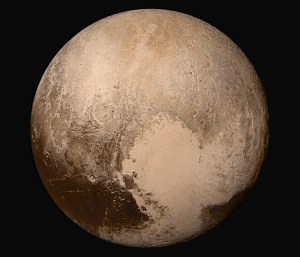
Image of Pluto taken by New Horizons camera / Image courtesy of NASA
Even though less than half of New Horizons data has been transmitted back home to date, the science team has already had their work cut out for them. NASA described the findings of Pluto as “more interesting and puzzling than models predicted.”
A dense hazy atmosphere, floating icy hills, and an icy surface that appears to have changed in recent history and may be actively changing today are just a few of the discoveries that have come out of the New Horizons mission.
Much of the geological diversity stems from the multiple volatile ices on the surface. Pluto has methane, nitrogen and carbon monoxide ice that seem to go through freezing and precipitation (perhaps snow) cycles.
These cycles occur as Pluto moves closer to and farther away from the sun during its 248-year, highly elliptical orbit. When Pluto is farther away from the sun, part of its atmosphere can freeze and fall to the ground. When it comes closer to the sun, the surface ice will sublimate back into gas.
On Earth, the only molecule that constantly goes through similar large-scale cycles is water.
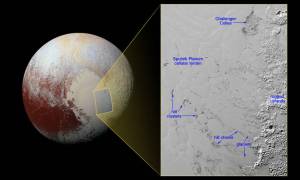
Hills of water ice appear to float on a sea of frozen nitrogen / Image courtesy of NASA
High resolution imagery of Pluto’s surface have revealed what scientists believe to be floating icy mountains. According to a NASA press release, Pluto’s nitrogen ice glaciers appeared to be carrying “numerous, isolated hills that may be fragments of water ice from Pluto’s surrounding uplands.”
Water ice can float on nitrogen ice because water ice is simply less dense than frozen nitrogen. This scenario would mean that mounds of water ice are actively moving across Pluto’s icy surface over time, making the dwarf planet much more of a dynamic world that we previously believed.
Pluto’s atmosphere particularly surprised the New Horizons team.
“We’ve discovered that pre-New Horizons estimates wildly overestimated the loss of material from Pluto’s atmosphere. The thought was that Pluto’s atmosphere was escaping like a comet, but it is actually escaping at a rate much more like Earth’s atmosphere.” – Fran Bagenal, University of Colorado, Boulder, lead author of the particles and plasma Pluto paper
With new data from the New Horizons mission, it’s now believed that Pluto’s atmosphere contains layered hazes and is colder and denser than expected.

Haze layers above the surface of Pluto taken by New Horizons camera / Image courtesy of NASA
New Horizons launched on January 19th, 2006 and traveled 3 billion miles over the course of 9 and a half years to reach Pluto. At the time of launch, Pluto was still considered a regular planet. It wasn’t until August of 2006 that the International Astronomical Union voted to demote Pluto to dwarf planet status. That decision is still debated in some scientific circles to this day.
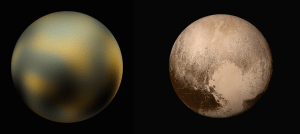
Left: Old image of Pluto created using the Hubble Space Telescope. Right: New image from New Horizons / Images courtesy of NASA
On July 14th, 2015, the spacecraft had reached its destination and performed a successful flyby of Pluto, providing the very first close-up look at the dwarf planet. Prior to New Horizons, our best picture of Pluto was a grainy, blurry image provided by the Hubble Space Telescope. During its approach, New Horizons sent back a now-iconic image of Pluto, complete with a heart-shaped geological feature on the surface.
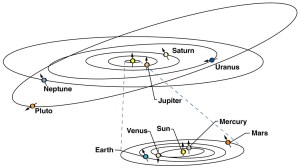
Orbital inclinations of planets in the solar system / Image courtesy of NASA
To scientists, Pluto had always been a bit of an oddball. The small dwarf planet has about 6 percent the gravity of Earth, it has a higher orbital inclination than the other solar system planets and it rotates at a fairly extreme tilt. Its orbit brings it much farther away from the sun in an area known as the “third zone” of the solar system.
Exploration missions have focused on larger and closer bodies in the first zone (innermost terrestrial planets) and even the second zone (outer gas giants), but not much was known about planetary bodies like Pluto in the third zone.
New Horizons was the first mission to explore this “new” type of planetary world.
Because of its distance from Earth, data from New Horizons, traveling at the speed of light, takes 5 hours to reach us. Using its 7 science instruments, the mission captured 50 gigabits worth of data during the 9 days surrounding the flyby.
With the rest of the data expected back by the end of this year, we’re likely to see even more Pluto discoveries in the months to come.
